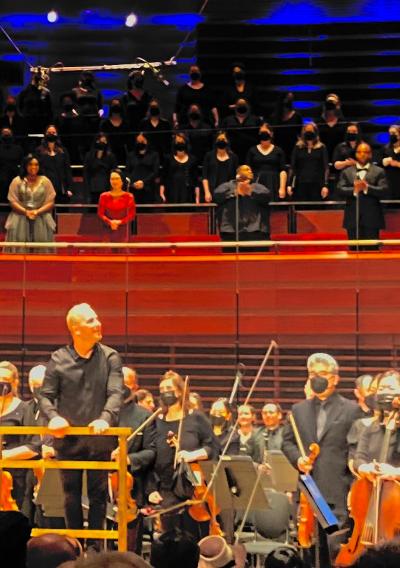
Between February 22 and June 5th, Beethoven’s Symphony No. 9 (“Choral”) rewrote itself — though the notes, orchestra, conductor and chorus were the same.
The earlier performance by the Philadelphia Orchestra and its music director Yannick Nézet-Séguin was at Carnegie Hall as a finale to the orchestra’s Beethoven cycle there; the later one concluded the 2021-2022 season at its usual home, Philadelphia’s Kimmel Center. The earlier performance was fast, Toscanini-fast, as if to keep up with Beethoven’s metronome markings, and some sections of the orchestra seemed caught by surprise. The later performance was still brisk, but not nearly as hurried, and had far more force and greater variety of color and inflection. And it was angry — a not-so-coded protest if I’ve ever heard one.
What happened between February and June? The world around Beethoven changed. On February 22, Ukraine was yet to experience its current invasion. The Buffalo supermarket shooting (maybe) hadn’t been planned. But on June 5, only 11 blocks away from and 14 hours before the concert, shooting had erupted in Philadelphia. Prior to the performance, Nézet-Séguin quoted casualty statistics that were maybe already out of date — particularly if you count Chattanooga. And Summerton, SC. And Saginaw, MI. And Mesa, AZ.
“We are all one society … not left, not right … and we have to take care of it,” he said.
Classical music, by definition, is thought to be aloof from passing events. Yet in the past three years, no artistic medium has pivoted so dramatically and repeatedly as the symphony and opera worlds. Around the globe, concerts are full of non-European names among composers and performers — and audiences are willing, even eager, to hear them. Both Beethoven programs featured Gabriela Lena Frank’s ten-minute choral work, Pachamama Meets an Ode, that draws on her Peruvian heritage and knowledge of indigenous painters in Cusco — though performance-wise the piece still hasn’t found its legs (and really requires surtitles for more immediate apprehension of the message).
Most radical, perhaps, is how the meaning of well-established music can change, and in this concert, did change.
The February tempos seemed to be holdovers from the Chamber Orchestra of Europe, with whom Nézet-Séguin had recorded all of the Beethoven symphonies. The Philadelphia Orchestra can be as nimble as a chamber orchestra at times, but Carnegie Hall wasn’t the place to push that envelope. The considerable advantages of Nézet-Séguin’s approach stood to be overall structural coherence and a sense of unity and purity, though the third movement’s slower speed was that of a more traditional performance. Later in the final movement, the climactic moment just before the Turkish band entry was loud, long and, amid such classical rigor, a bit tasteless.
In June, what the symphony was supposed to be was secondary to what it could say.
Interpretive decisions couldn’t be called traditional or unorthodox, Classical or Romantic, left or right (as Nézet-Séguin said in his pre-performance remarks). Slower tempos, though, were the key. Greater speed pushes the capabilities of the instruments in ways that limit how a phrase can be played. Maybe thrilling velocity is achieved, but a kind of sameness sets in. (That, to me, is the lesson from John Eliot Gardiner’s earlier to later, and slower, performances.)
Nézet-Séguin’s June 5 performance was so rich as to have shifting meaning in every phrase. The sequential repetition that ends the first movement had mounting tension that was almost unbearable. At times, the heat seemed turned up as high as it could go. And then it got hotter. The busy second moment maintained its usual strict silhouette but had had different inferences at every turn. At times, you felt him summoning the horns to go beyond the normal bounds of duty — and with penetrating effect. The third movement was its sublime self but with nagging harmonic undercurrents. Though as emphatic as ever in its message of universal brotherhood, the final movement lacked any sense of trying to achieve a superficial effect.
Yes, as great as this music is, it can fall into claptrap, and the Feb. 22 performance had some elements of that. But the breakneck tempos that challenged tenor Matthew Polenzani in February were adjusted for Limmie Pullman in June. Other soloists in the distinguished lineup — Angel Blue, Mihoko Fujimura, and Ryan Speedo Green — were about the overall message rather than any individual effect.
It won’t always be like this. And that’s the point. Classical music masterpieces aren’t like cathedrals that survive wars and hurricanes, and are re-appreciated by new generations. Great musical masterpieces are more like prisms that constantly maintain their own character while refracting their surroundings in always-evolving and unexpected ways.


Thanks for this capturing of the concert(s). It is a beautiful reminder of the role we have as audiences to be moved by events and by the artistic response to them. We can claim some power from this collective action inspired by the event whether or not we were there ourselves (though I wish I had been).